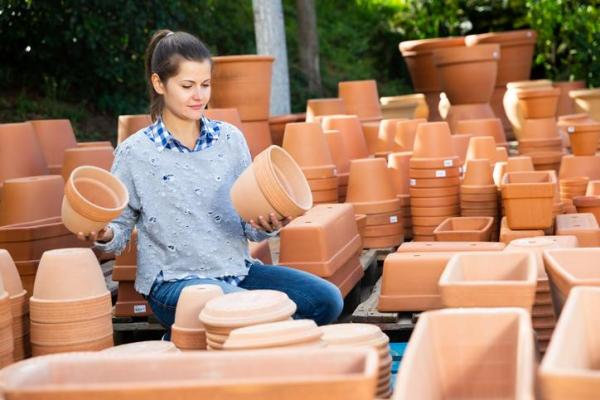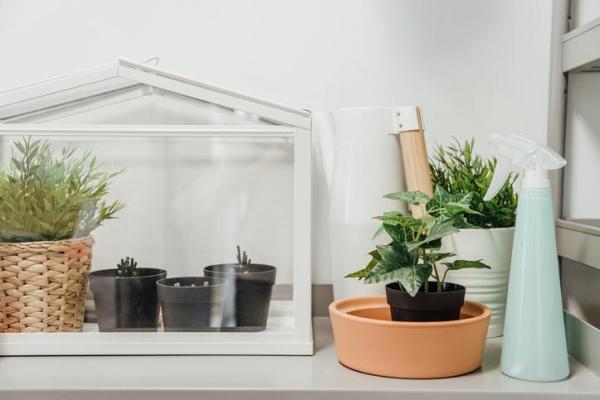
Although it may seem simple, in order to be successful in caring for houseplants it is important to know the finer details. Many people complain their plants grow very slowly and this may be due to various factors. These include the type of irrigation, exposure to the sun, temperatures of the home or the type of soil being used. All of these can affect the proper development of your houseplants.
In the following oneHOWTO article we provide you with key information explaining why your indoor plants are not growing. We also explain the best tips and tricks to care for them correctly. Identify the growth issues affecting your houseplants and discover the best solution to help them grow in a healthy way.
Lack of watering
Watering is one of main the factors that directly influence the growth of a houseplant. If you've been thinking ‘why do my plants grow too slowly?’, pay attention to the amount you water them. If you don't give your plants the correct amount of water, not only will they look droopy, yellowish, dry or even wilted, but they won't grow well.
A lack of water causes the plant's reserves to be consumed causing it to become dry and wilted as it cannot focus its efforts on growing. To help them grow quickly, it is advisable to check the amount of water your houseplants require. By knowing the specific species you have at home, their requirements and especially their watering needs, you will be able to give them the necessary amount of water and with the right frequency.

Overwatering
It is as bad to overwater a houseplant as it is to underwater it. In fact, the former is one of the common possible causes of houseplants dying. Overwatering is the said to be the primary cause of houseplant death, so you must be very careful when watering them if you want them to grow healthy quickly.
Overwatering a plant causes the roots to struggle for air and vital nutrients needed to grow. Additionally, the excess water will eventually cause root rot, leading to the plant's death. The most characteristic signs of overwatering in a houseplant are mold or fungus in the substrate, constantly soggy soil, and wilted or yellowing leaves.
If you notice that your plants are growing slowly, you will need to reassess irrigation. Know the needs of your houseplants and allow the soil to dry to the touch between watering to ensure good development of the plant.
Lack of space
Are your houseplants not growing? Lack of space may be another reason. Plants go through different stages of growth and the roots need enough space to develop. If your plant is growing slowly, perhaps it is because the current pot has become too small. In this case, the roots have curled up due to lack of space and are turning in on themselves, unable to find a way to continue growing.
If this is the reason why your houseplant is not growing properly, you will notice some of the following signs:
- Roots protrude from the bottom of the pot.
- When you pull the plant out, you will see that there are more roots than soil.
- The plants have stopped growing.
- The water no longer soaks into the soil, but goes straight to the bottom, as there is hardly any soil left.
If you want your plant to continue to grow and develop, you will need to change its pot and re-plant it. Remove the old soil between the roots and also prune all the damaged roots so that they develop healthily, but be careful not to damage the large roots. Once the plant is in a pot with more space you will see how it soon starts to grow faster.

The importance of light
Another of fundamental factor that can affect proper growth are the levels of light the plant receives. If you want to ensure its survival and development, you should imitate as closely as possible the natural environment of its species. To do this, you should consult the specific needs of each houseplant to provide the appropriate level of light.
If you notice that the plants are curling downward, the edges of the leaves are yellowing or that the new leaves stay much smaller than the old ones, your plant is receiving more light than necessary. In this case, you should move it away from the window or make sure the light it receives is not direct. You can filter it with a curtain.
If your plant grows slowly, the stem is longer than it should be or the leaves do not have much color, it is because it is too far from sunlight. The solution is to relocate it so that it receives more light. With this change of location you will notice how the plant becomes more slender and grows quickly.
If your home receives little natural light we advise you to take a look at this other article on the best large indoor plants for low-light.
Inappropriate temperature
Another possible reason why houseplants do not grow is that the temperature is not right. So, if your houseplants are not growing you should check the temperature they are being exposed to. Generally, houseplants grown at home or in the office need temperatures ranging between 18°C and 23°C (64-73 ºF).
It is important not to exceed the maximum temperature because indoor plants are unable to cope with very high temperatures. This is especially true if the levels of light or air humidity do not correspond to those of their natural environment. Equally, low or minimum temperatures can damage their growth, even causing the death of the plant. This is different for outdoor plants which do not tolerate being indoors.
Therefore, if you want the correct growth and for your plants to thrive properly, you should always keep them at a moderate temperature.
Soil and fertilizers for indoor plants
You may not be using the right soil for your plant to grow healthily. Don't forget that plants need specific soil according to their characteristics and needs. Ask the nursery or gardening store where you buy your plant what is the best substrate for it.
In addition, some directly start using fertilizers when they see their indoor plant isn't growing properly. However, you have to be careful with fertilizers and always give the right amount to your indoor plants. This is so that they get the necessary nutrients as they grow, e.g. nitrogen, potassium and phosphorus.
If you don't give them fertilizer, you will see that their stems will atrophy and the new leaves will be smaller, as their growth will have slowed down. However, providing too much fertilizer can cause the leaves to dry out or turn brown, especially at the tips. If you have found yourself in the latter situation, you will need to increase the humidity around the plants by bringing them into the kitchen or bathroom.
Therefore, when you purchase the plant you will also have to find out what kind of fertilizer is needed, how much and how often.

Ignoring plant pests
Even when discussing indoor plants, it is important not to pests since they can slow down growth, cause various diseases or conditions and even kill the plant. The most common pests on indoor plants are:
- Red spider mite
- Aphids
- Mealybugs
- Soil insects
- Scale or coccoid insects
- Tisanoptera
- Powdery mildew, such as downy mildew
Try to eliminate pests with natural pesticides rather than using chemicals that can also be harmful to plants. We advise you further in this area with our article on how to get rid of red spider mites from plants.
Frequent relocation
Houseplants grow by adapting to their environment. However, if you frequently relocate them you can cause them unnecessary stress.
If your plant is growing quickly and healthily because it has proper levels of light, temperature and humidity, it is best not to move it. This way, you will not interrupt its development or harm its health. Move the plant only when you notice that it is not growing correctly. Otherwise, try to always leave it in the same place.

How to care for houseplants
Now that you know the factors that influence how well your houseplants grow, it's time to learn more about how to properly care for houseplants.
Choosing the right plant
We recommend you go for simple, easy-care and hardy options such as: cactus, snake plant, silver pottos, bamboo, ivy, fern or aloe vera. Don't make the common mistake of basing your choice only on aesthetic criteria. Purchase the plant taking into account the environment in which it will live, the location and how much time you will dedicate to its care.
You can choose your houseplants by different personal factors, if they are suitable to your home environment. If fragrance is important to you, why not check out our article on the best aromatic houseplants.
Basic care of indoor plants
For your plant to survive and grow healthily you should note the following principles of basic care:
- Soil: as soon as you get an indoor plant, it is advisable to change its planter so that it has enough space to grow. Add new soil as well, using the substrate that best suits it.
- Watering: know the type of watering needed for the chosen plant. The amount depends on the conditions and needs of the plant. However, it is always better to water a little than a lot, since you can always rectify a lack of water, whereas excess water will drown them. The trick is to stick your finger in the soil to check the moisture level before watering again. You can spray water on jungle or woody leaves to moisten them.
- Light: It is important for plants to receive a good dose of sun, but not direct sunlight. Look for a good source of light for the location of your plant.
- Fertilizer: in addition to water, light and substrate, plants require fertilizer to enrich the soil. Soil can lose nutrients over time so you should fertilize the plant from time to time with a small amount of organic fertilizer to avoid harming it.
- Transplanting: since the plant will grow, it is very important to transplant it periodically in order to provide it with more space for its development. Look for larger pots and add new soil to encourage its growth. Always remember to compact the soil when repotting to avoid air pockets in the soil. If you are short of space, you can trim both the branches and base, so that they can stay on in their current pot. Here we tell you more about how to transplant a plant.
For more details, you should look at the specific plant variety and see if your home meets their requirements. Check out our articles on how to care for a silver satin pothos and how to care for an areca palm plant for just two examples.
If you want to read similar articles to Why Are My Indoor Plants Not Growing, we recommend you visit our Gardening & plants category.